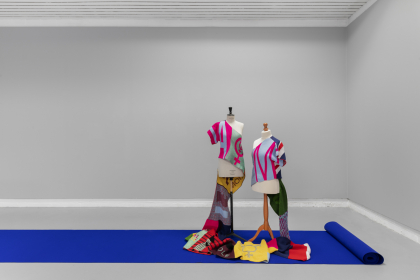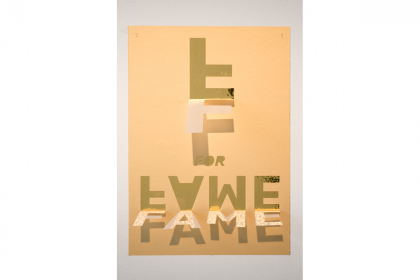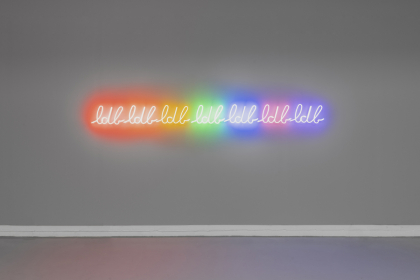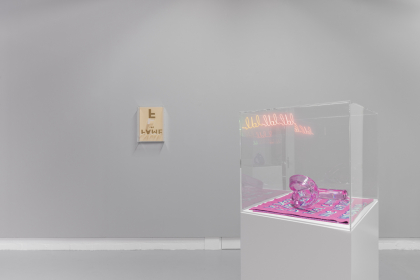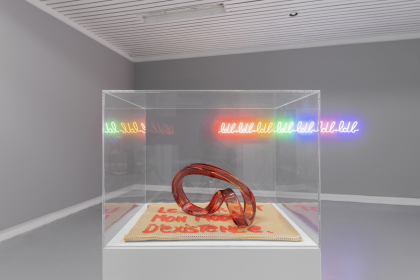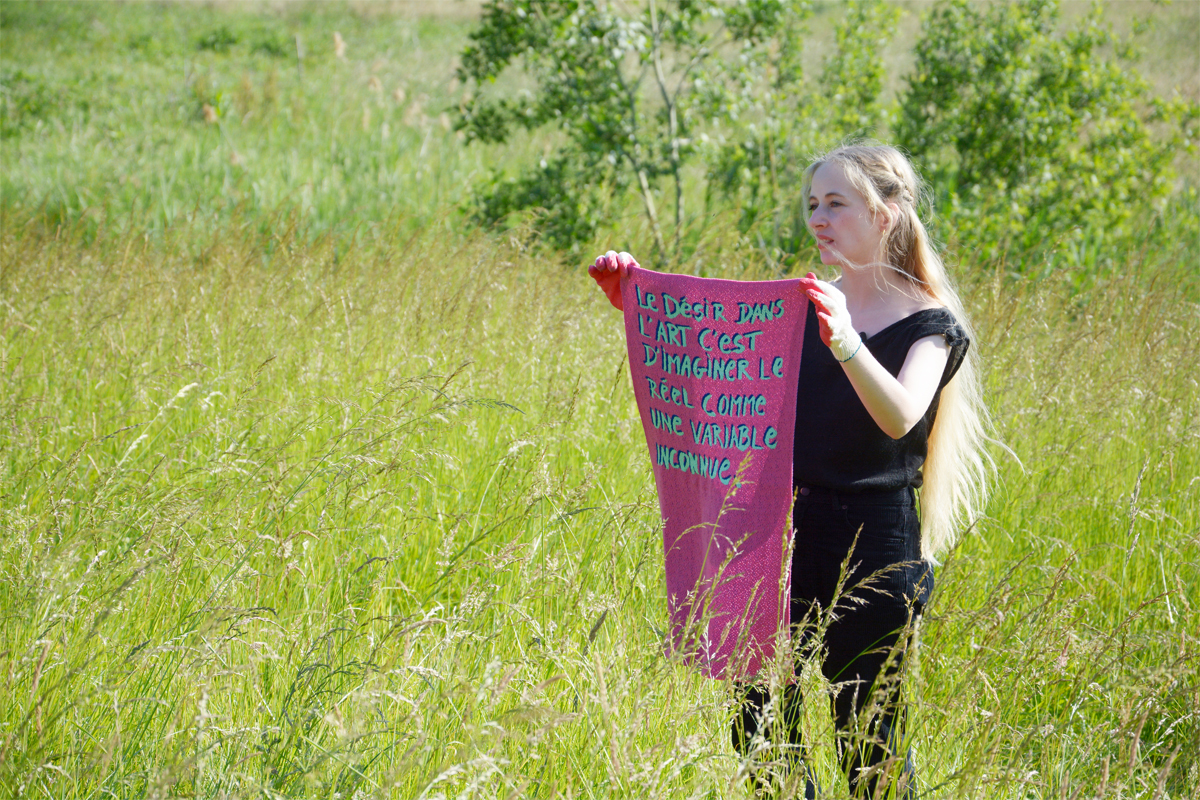
The Curator is Absent.
After my experience realizing work in glass and in tricot, I started wondering how to combine these two materials in one single piece. The physical properties of these two materials are in strong opposition, while their production process shares one large similarity; an un-controllability that provokes an unforeseen and surprising result. During the making of a glass work or a work in tricot, one gets lost in the complexity and un-predictable behaviour of the material and it is only the desire to make the piece that guides this process. This process of getting lost is, according to me, a necessity in order to create art. The desire to do this new work and the drive towards realizing this object that successfully combines these two materials turned the question upside down: how can one make this desire of getting lost in the complexity of the making of a work visible?
I write on a piece of paper; “Le désir est mon mode d’existence”. I decide to ask 6 other protagonists that have a relationship with the artwork—the patron, the curator, the collector, the viewer, the art critic, and the gallerist—to each write a sentence about what they desire in art. The result is a set of statements that form a poetic landscape of possible desires surrounding a work of art. In the studio, the texts are handwritten and put into a tricot pattern. For almost a year, with my assistant Diane Levasseur and the collaborators of the Textiel-lab in Tilburg, I tried out various ways to realize them. This experimentation finally resulted in seven banners in different colours expressing the seven statements about desire.
The form of the glass finds its source in Lyotard’s book Libidinal Economy. Here, the Möbius strip or endless loop is the figure representing desire, seen as the fundamental condition to create or produce. To realize a Möbius in glass, I experiment with the glassblowers of the Cirva. We succeed to make the strip purely through movement. Through this process, each of the strips has a different, unpredictable form, but still correspond to the mathematical characteristics of the Möbius strip.
These two, the knitted text banners and the glass Möbius strips are then combined to become a unity of form and language, expressing in a verbal and a formal way the concept desire. The use of mathematic formulas and language as material in art is part of the conceptual tradition. Their combined use in a single work however is less frequent.
In June 2020, I decide to install the work in the park of the White House gallery and to activate the piece by inviting four friends to act out the different statements by the protagonists. The works are placed in a circle on pedestals. I walk from one to the other, take a Möbius and walk away in the landscape while the other person unfolds the banner, declares the text, and walks towards the center of the circle. I decide to document this first activation by placing a camera in the center of the circle. After the seven movements are registered, we return backwards, creating as such the figure of the Möbius as the ground figure of the activation itself. This is the first appearance of the work.
In April 2021, the work will be shown in an exhibition in the project space of the White House gallery, and so I began to think about what the re-appearance of the work could be. Normally the gallery invites a curator to work on the exhibition with the artist. They ask several, but no one seems available to do the job; hence the title of the show becomes: The Curator is Absent.
I decide that this exhibition can become an experiment in relation to the content, the methodology, and the search for a mode of presentation, a topic that I started working on in the framework of my PhD project called The Archive of Disappearance. In this research, I study among other topics, the work of Hélio Oiticica and more particular his idea of the “work-site”, in the context of the cycle of the appearance and disappearance of a work of art.
The idea of the “work-site” of Hélio Oiticica is most developed in his work Parangolé. Oiticica links the “work-site” to his concept of the “probject”: this is the probability that a work becomes activated by a viewer-participant. Through the activation of the work—in the case of Parangolé wearing the artwork and dancing with it—the meaning of the work appears. A site or context for the work comes into existence. For Hélio Otticica this unity is necessary, and it is the way to install the meaning of a work through the experience of the work. His position can be seen as an institutional critique and in strong opposition to the current paradigm of the independent curator, who is defining an external context, and as such the work’s meaning. For Hélio Oiticica, the meaning of the work is embedded in the activation of the work and directly made by the viewer-participant. Considering his works as living entities in a taxonomic way of ordering, the meaning of the work can develop itself endlessly but always through the unity of work-site that is created through this participative process. I wonder if I can use the concept of the “work-site” in the exhibition at the White House project space.
Le Désir represents desire in a formal and linguistic way of the seven protagonists that visit any exhibition. Every future visitor of the show comes with a desire for art and fits in at least one of these categories presented; everyone is a visitor and/or an artist, a curator, an art critic, a collector, a patron, or a gallerist. This means that the second activation of the work becomes the visit of the exhibition itself, because it represents every one present in the room. The meaning of the work is simply the exhibition itself. Everyone visiting has a desire in art and can be placed in two or more categories of the seven positions taken. This means that the work itself is a representation what is happening in an exhibition. The visitor of the exhibition activates as such the work a second time, and the meaning of the work re-appears through this activation.
Working on the idea of the work-site, I decide to return to some previous work, and especially the work I am I, which also asks to be activated in order to create a work-site. The work represents the identity of two friends, Lucie and Rachael, both with a mixed and multi-layered gender, national, and sexual identity. The imaginary of representation is based on the answers of a list of questions and found images on the internet. These images are put together in a linear sequence starting from the middle and developing towards both ends in the form of a sleeve. For the activation of the work, two people (Rachael and Lucie, or others) are enrolled in the 9-meter-long tricot and unroll one image at a time, stating (I am) or questioning (Am I?) the image they unroll as being part of their identity. The work is like a mirror and an exposure of one person towards another one.
The work I am I completes Le Désir as every visitor of the exhibition has, in addition to a desire to see art, of being an artist, curator, art critic, patron, gallerist, collector, or visitor, also a sexual, national, gender identity, and has a certain age, a name, a totem animal, etc. This makes every person unique but also fluid because identity is always created in relation with others and is a changing process in time.
I add another work in the show, the neon piece titled The Richard Of York Gave Battle in Vain. This work represents my signature “ldb" in handwriting and as a neon sign decomposed in the seven colors of the rainbow. While before it was placed on seven pedestals, here they are presented in a linear line on the wall, readable as a tag or any other form of appropriation.
Lieven De Boeck


